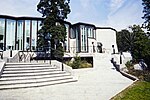St. Mary's Church, Helsinki

St. Mary Catholic Parish (Finnish: Pyhän Marian kirkko, Swedish: Sankta Maria kyrka) is a Roman Catholic parish based in the Meilahti neighborhood of Helsinki, Finland. Pastoral care is entrusted to the Priests of the Sacred Heart.Like other Finnish Catholic parishes, which are all part of the Diocese of Helsinki, the area served by the parish is broad, stretching from the western extent of Uusimaa to Riihimäki to Hanko. The parish area includes the diocesan retreat center, Stella Maris; the diocesan broadcaster, Redemptoris Mater; and the Carmelite convent in Espoo. The vast majority of parishioners reside in Greater Helsinki, including many foreigners; regular services are held in Swedish, English, Vietnamese, Polish, Spanish, and German as well as Finnish.St. Mary's was established in 1954, the second Catholic congregation in the western Helsinki area to be established since the Protestant Reformation. Bishop Willem Cobben consecrated the parish church on December 6, 1954, whose facilities include a church hall and rectory. A parochial school was opened the same year.
Excerpt from the Wikipedia article St. Mary's Church, Helsinki (License: CC BY-SA 3.0, Authors, Images).St. Mary's Church, Helsinki
Mäntytie, Helsinki Meilahti (Western major district)
Geographical coordinates (GPS) Address Website External links Nearby Places Show on map
Geographical coordinates (GPS)
| Latitude | Longitude |
|---|---|
| N 60.1917 ° | E 24.9003 ° |
Address
Pyhän Marian kirkko
Mäntytie 2
00270 Helsinki, Meilahti (Western major district)
Finland
Open on Google Maps







